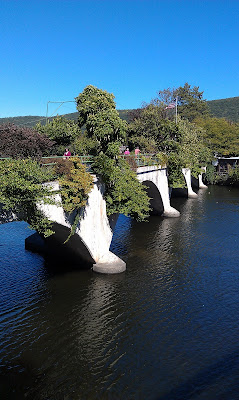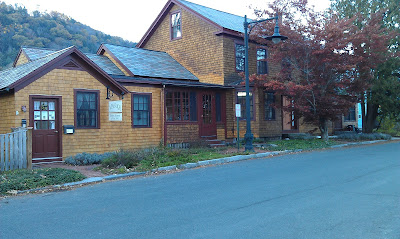 |
| Smalandsvav sample. |
My next weaving experience that week was Smalandsvav. We had gone over basic design possibilities, and with that sheet in hand, and a bobbin with two shuttles, I decided to weave two colors at once. It must come from my using three colors when cranking socks?
 |
| Smalandsvav is a double harness weave. |
Smalandsvav is not woven on a drawloom but is a double harness weave, requiring two sets of shafts. The above photo was taken to help me with setting up a loom at home when I weave this at home.
 |
| Small extension added to the loom. |
Smalandsvav was set up on an Glimakra Ideal loom with a short extension added to help with achieving the shed. A double-bobbin shuttle was used.
 |
| Cattail design being woven on a shaft draw system. |
For weaving on the shaft draw system, also set up on a Glimakra Ideal, I chose a design of cattails. What I did not realize (and still need to understand) was there was an "x shaft" in the design. Though I worked from the center of the design when pulling the cords, you can see there are "double" cattails in the photo above that should be single. I need to get "Damask and Opphamta" out to read and understand what was going on here.
 |
| Loom with shaft draw system. |
Shaft draw systems are for weaving designs that repeat across the width of the fabric. (The opphamta attachment also produces designs that repeat.)
 |
| A better view of the weaving, nearly completed. |
My last weaving was on a loom with the Myrehed single unit draw. With that setup, you can do freeform designs, though the design I had chosen (the first day of class) was a balanced design, with border I added.
 |
| Drawcords are in front of weaver instead of overhead. |
This loom had the newer Myrehed single unit attachment with drawcords coming down in front of the weaver, instead of the older style single unit drawloom with drawcord warp overhead (as in the single unit with lashes in the previous post).
The charts/designs used at the looms were kept on a magnetic board that sat on the bench next to you. Pull the cords according to the chart, weave the required rows (depending on structure), release the cords, pull the new cords, weave,.... until design is completed.
 |
| A better view of the weaving in progress. |
The warp was black, and I chose a bright red weft. The only issue I had was getting used to focusing my bifocals on the cords so as not to have errors in the weaving. I did end up with one error, but there was not enough time to cut it out and re-weave. At home, I would never have left it in no matter how far back I had to go. However, it was the last afternoon and I decided having a finished design was more important at that point.
 |
| Looking at the shaft draw piece. |
 |
| Class Photo from Drawloom Basics, Sept. 17-21, 2012. |
Part 3 will have photos of my samples (off-loom), and brief information on fibers used, sett, and so on.
Next will be one or two posts with photos of woven samples we viewed during the week as well as woven pieces on display.
Following those will be a post on the Helena Hernmarck tapestry exhibit "In Our Nature," at the American Swedish Institute in Minneapolis, along with a few pics from Swedish handknits and Swedish lace exhibits that were on at the same time.













































